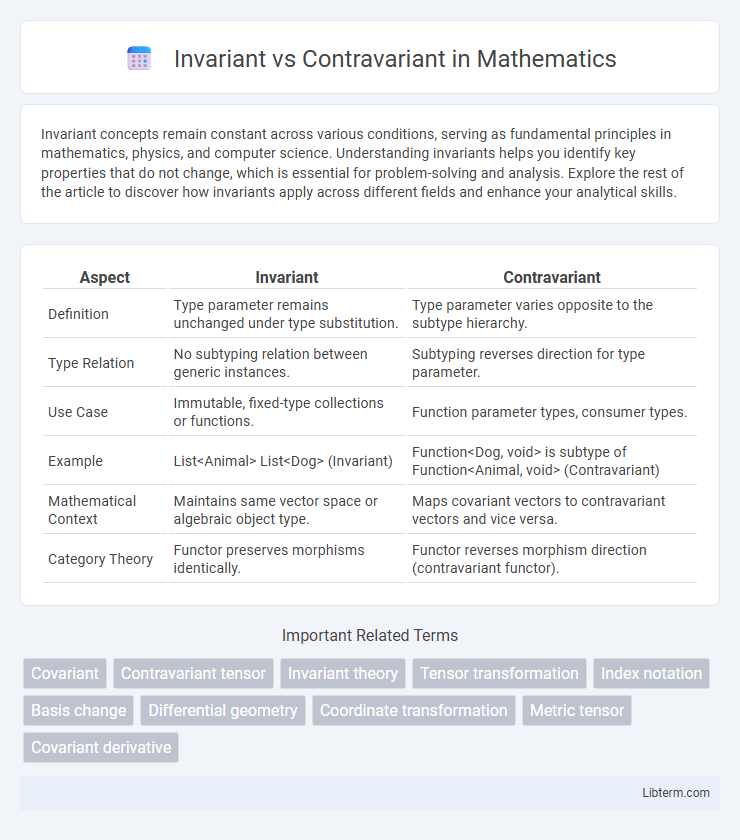Invariant concepts remain constant across various conditions, serving as fundamental principles in mathematics, physics, and computer science. Understanding invariants helps you identify key properties that do not change, which is essential for problem-solving and analysis. Explore the rest of the article to discover how invariants apply across different fields and enhance your analytical skills.
Table of Comparison
| Aspect | Invariant | Contravariant |
|---|---|---|
| Definition | Type parameter remains unchanged under type substitution. | Type parameter varies opposite to the subtype hierarchy. |
| Type Relation | No subtyping relation between generic instances. | Subtyping reverses direction for type parameter. |
| Use Case | Immutable, fixed-type collections or functions. | Function parameter types, consumer types. |
| Example | List<Animal> List<Dog> (Invariant) | Function<Dog, void> is subtype of Function<Animal, void> (Contravariant) |
| Mathematical Context | Maintains same vector space or algebraic object type. | Maps covariant vectors to contravariant vectors and vice versa. |
| Category Theory | Functor preserves morphisms identically. | Functor reverses morphism direction (contravariant functor). |
Introduction to Variance in Type Systems
Variance in type systems defines how subtype relationships between complex types relate to the subtype relationships of their component types. Invariant types require exact type matches, meaning no subtype substitution is allowed, preserving strict type safety. Contravariant types reverse the subtype relationship, allowing a function or type to accept supertypes of a specific type parameter, thereby enabling flexible type assignments in function input positions.
Understanding Invariance
Invariance in type systems means a type parameter is neither substitutable by its subtypes nor supertypes, requiring an exact match for type compatibility. This strict type relationship ensures type safety by preventing unexpected behaviors that can occur with covariance or contravariance. Understanding invariance is critical for designing robust APIs and data structures where precise type control is necessary, such as in collections that must only accept elements of a specific type.
The Concept of Covariance
The concept of covariance in type systems describes how subtyping relationships are preserved when applying generic type constructors; for instance, if type B is a subtype of type A, then a covariant generic type G is a subtype of G. Invariant types do not allow any subtyping relationship between G and G, meaning type parameters must match exactly, while contravariant types reverse the subtyping direction, making G a subtype of G when B is a subtype of A. Covariance is commonly used in read-only or output positions to maintain type safety while supporting polymorphism, enabling more flexible and reusable code.
What is Contravariance?
Contravariance in programming refers to the ability of a type system to allow a function or method to accept parameters of a more general type than originally specified. It enables safe substitution when a function expects an argument type but receives a supertype instead, enhancing flexibility in type hierarchies. Commonly seen in generic type parameters for input types, contravariance contrasts with covariance, which deals with output types.
Key Differences: Invariant vs Contravariant
Invariant types maintain exact type matching, ensuring that a generic type parameter neither accepts subtypes nor supertypes, which preserves strict type safety. Contravariant types allow a generic type parameter to accept supertypes, enabling more flexible method parameter substitution while maintaining type correctness. The key difference lies in type substitution: invariant types disallow variance, whereas contravariant types permit input types to vary in a reverse hierarchy, enhancing polymorphism in function arguments.
Real-World Examples of Variance
Invariant types require exact type matches, as seen in Java's ArrayList
Variance in Programming Languages
Variance in programming languages defines how subtyping between complex types relates to subtyping between their component types. Invariant types require exact type matches, preventing any subtype substitutions, while contravariant types allow substitution with supertypes in method parameters, enhancing flexibility in type hierarchies. Understanding invariant and contravariant relationships is crucial for designing type-safe APIs and ensuring robust type-checking in languages like Scala, C#, and TypeScript.
Benefits and Drawbacks of Each Approach
Invariant types ensure strict type safety by enforcing exact type matches, reducing runtime errors but limiting flexibility in generic programming. Contravariant types allow substitution with more general types, enhancing code reusability and adaptability, but may introduce type safety risks if not carefully managed. Choosing between invariant and contravariant depends on balancing the need for strict type correctness against flexibility and code maintainability in type hierarchies.
Best Practices for Using Variance
Invariant types guarantee exact type matching, ensuring type safety at the cost of flexibility, making them ideal for collections where modification is needed without type ambiguity. Contravariant types accept parameters of less derived types, enhancing flexibility in method inputs while preserving type safety, which suits scenarios like event handlers or comparators. Best practices recommend using invariance for mutable data structures and contravariance for input parameters in interfaces or delegates to leverage type safety and code reusability effectively.
Conclusion: Choosing the Right Variance Strategy
Choosing the right variance strategy depends on the type relationships and how you intend to use the data structures or functions. Invariant types enforce strict type equality, ensuring safety but limiting flexibility, ideal for scenarios requiring precise type control. Contravariant types allow accepting more general input types, enhancing flexibility when defining function parameters or consuming data, making them suitable for input roles and broader type compatibility.
Invariant Infographic

 libterm.com
libterm.com